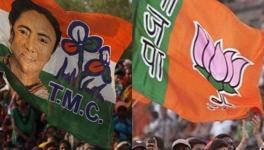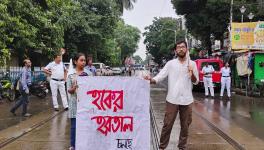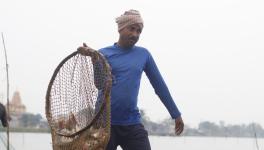Amlasole -- A Saga Extreme Poverty Alongside Scenic Resorts in Bengal’s Jhargram
Entry to Amlasole village
A tin signboard of a food garden for nourishment of residents of a village in Amlasole lies along with others pieces of garbage near a dilapidated mud house. Puchi, the daughter of Lakshmikanta, had found the signboard lying near a bush kept and brought it home. She and her brother Kaliya used to play with it. Ask any villager about the fruit garden, they are all clueless. But, according to the Mahatma Gandhi National Rural Employment Guarantee Scheme (MGNREGS), 2020- 21, a fruit garden has been listed as made under the scheme.
The Amlasole region in the adivasi-dominated Jharagram district of Bengal is known for the poor living conditions of the community. In 2004, five Sabar (a primitive tribal community) members died reportedly due to starvation. This incident was widely reported in the media, after which various non-governmental organisations (NGO), government officials, the then ruling party (Left Front) and the Opposition parties had visited Amlasole. Everyone made promises to stand beside the Sabar community.
Since then, 18 years have gone by, but what is the state of affairs in Amlasole now? How do people earn their livelihood, especially those from the Sabar community?
This writer visited Amlasole a few days ago with Madhu Sudan Mahato, and local social worker and Buddheswar Mura, a tribal youth. The journey to Amlasole began from Banspahari (Jhargram district) on a motorbike. On the way to Amlasole, a dense forest called Chhurimara had to be crossed. On one side of the jungle lies the state of Jharkhand and on the other, lies West Bengal.
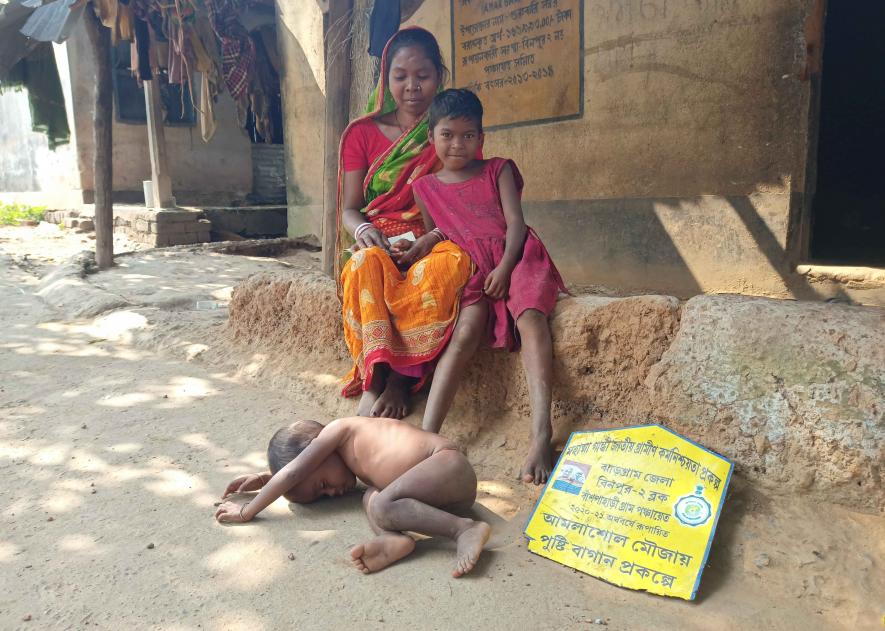
Puchhi Sabar with her mother and malnourished younger brother Kaliya.
Once upon a time, this was a “free zone” for Maoists, as the geographical location was favourable for their activities. They set up permanent shelters here and moved to adjoining areas for armed action. Upon information of police raids, they would frequently cut off the roads. At that time, this was termed a ‘blood-prone’ area. Several poor agri labourers, and Communist Party of India (Marxist) activists were killed by the ultra-Left. The image of faces hidden by a half-tied towel were common. These people were locally called the Bon (forest) police.
After crossing Kakrajhor and Moyurjharna, we finally entered Amlasole,and could see ripe paddy lying in the fields. There was one healthcare centre. A woman told us that it was built long ago, when Upen Kishku was the Tribal Welfare Minister of West Bengal. With his initiative, doctors and health workers from Kolkata used to visit the area every
week and provide treatment. The government hospital is situated at Kakrajhor, 5 kilometres from Amlasole and the primary health centre is located at Belpahari, 30km away from this remote village.
However, no progress has been made in the government health care system since 2004, said some local residents. At the time when the voluntary health centre was introduced in 2005, doctors and health workers would come here once a week, now they come once in two or three months, we were told.
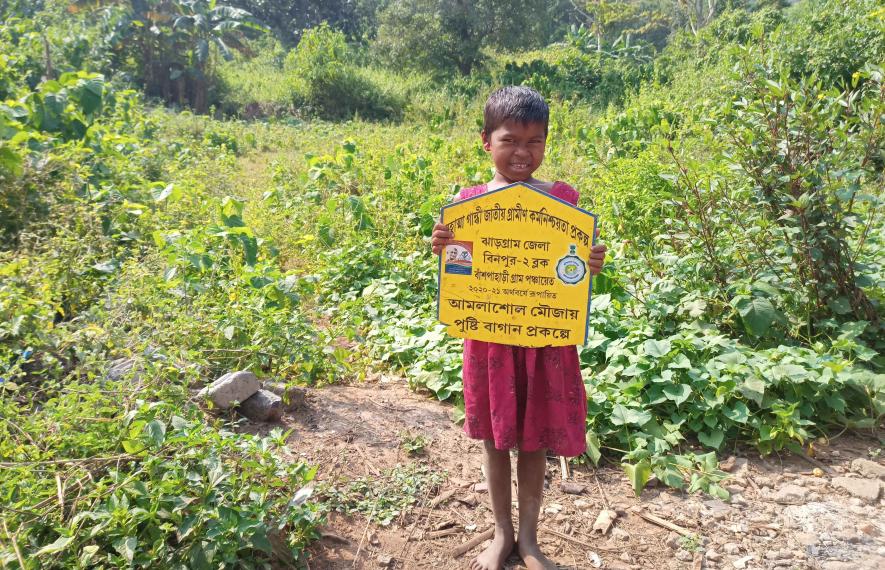
Puchhi Sabar holding fruit garden signboard at amlasole.
Chief minister Mamata Banerjee had visited Amlasole in 2014. Budhu Sabar, a resident of Amlasole, said when she came, the fields of the village were cleared for her helicopter to land. She did not come to the Sabar locality, but it was publicised in the media that this was the first time that a CM had come to Amlasole, he added.
“The people of Amlasole did not see her physically. She inaugurated a community centre in the village from the helipad,” claimed Sumitra Sabar. When asked if she ever goes to the community centre, she said: “No, the Sabar people never went there, and no one even asked us to” asking us: “What is going on there?”. Some people of Amlasole said that they did not even know when the Centre opens as they had always seen it closed. Some villagers said they heard that the community centre was being used to store Babui grass.
Sabar para is located at the end of the village. About 90 families live in the Amlasole village. Among the inhabitants, 14 families belong to the Sabar community, three Kurmi and the rest belong to the Mura (tribal) community. However, the Sabar community were found to be living a little different lifestyle, as they like to maintain a ‘distinct’ character.
In November 2004, there were reports of five Sabar deaths due to alleged starvation. They deceased were Samai Sabar (50), his daughter Mangali (33), Nathu Sabar (51), Sambhu Sabar (25) and Sanaton Mura. This writer met Nathu Sabar’s old widow Fulmani Sabar. Sitting in the courtyard of her broken house and looking at the nearby forest, her frail body covered in a tattered saree, she said her son Sanaton and daughter-in-law had gone together to cut Babui grass in the forest.
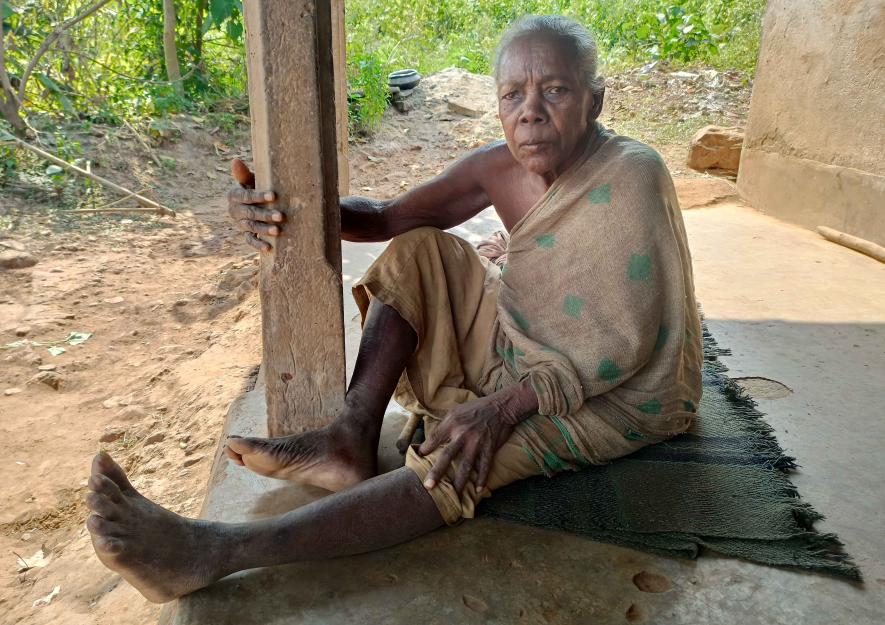
Fulmoni Sabar, widow of Nathu Sabar
When asked, Fulmani said did not get any widow or old age stipend or pension. Recalling the 2004 incident, she said in a feeble voice that numerous people had come and promised a lot. “They said they would help us in our livelihood. Yet, I did not receive my pension. Whom should I tell? Does someone even care for us?” she added.
Several advertisements have been published on the government’s Joy Johar project, according to which, it’s mandatory for the tribal community to get a stipend after the age of 60. The Chief Minister mentions this project on every occasion. But,18 years after the ‘starvation’ deaths, Nathu Sabar’s widow still awaits old age pension.
Bansi Sabar (64) and her brother-in-law Banamali Sabar (70) are in a similar condition. Whenever someone comes to Bansi, she holds up her Aadhar card and asks when she would get the stipend. Seven out of 14 Sabar families said they did not receive any kind of government pension, although they had reached the eligible age long ago. One villager said they were unable to communicate their problems to the panchayat or government officials. Most of them said they never go to the Banspahari gram panchayat office and neither do the panchayat members visit them.
Several electric polls were erected 14 years ago at Amlasole. Lakshmikanta Sabar said at that time, electricity was free for Below Poverty Line (BLP) families, but after the regime change in 2011, the electricity connection was cut off. They do not know why. The ruling panchayat built a new concrete road at Sabar Para, and a solar energy light pillar stands beside the road, but the Sabar people seldom get light from the solar project. “Only one lamp is lit,” said Lakshmikanta.
While talking with Lakshmikanta, a middle-aged man called out for someone. After a few minutes, Nimai, a young inhabitant of Sabar Para appeared before the man with an apparent empty oil tin. When asked what was in it, the man said that it contained jungle red ant eggs that are locally called Korkut. A decade ago, red ant eggs were synonymous with Amlasole. “Do you eat these eggs every day?” I asked. “Who told you? Can we afford to eat these? We buy rice after selling the ant eggs,” he said.
Red ant eggs are sold in the market at Rs 300 per kg. “The wholesaler buys from us at Rs70 per kg. The rice distributed through the ration shop does not last us the whole month,” said Nimai’s wife Sonamoni. She said: “We (husband and wife) live with two sons. Only a 12 kg ration of rice does not fill our stomachs. How can we think of buying vegetables and spices?” When asked if there was MGNREGA work here, she said there was no work in the area. The husband and wife said, “Work was there once a long time ago, after that there is no panchayat work in our locality.”
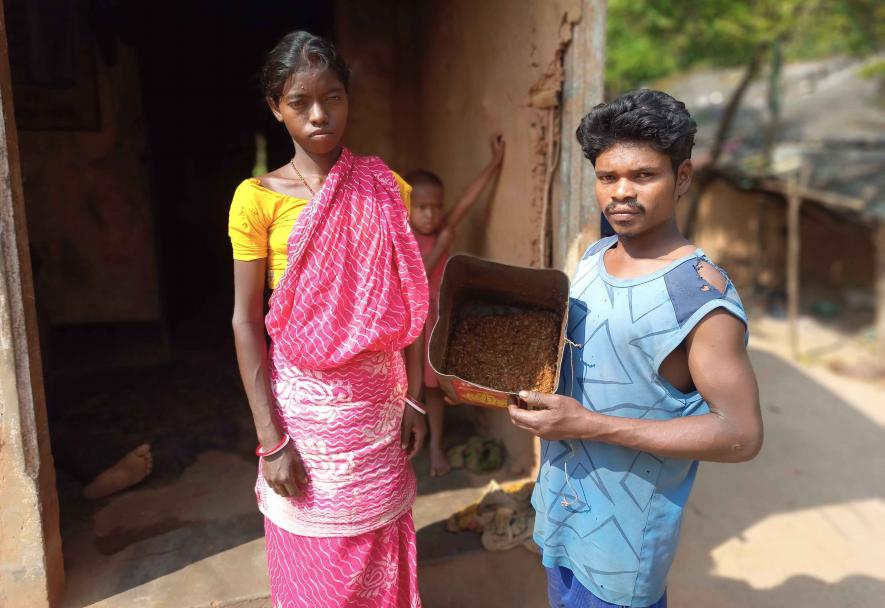
Nimai with his wife Sonamoni showing ant eggs
Men and women from the Sabar community of Amlasole go into the forest at 5 a.m in the morning to collect ant eggs. The red ants stick to Sal leaves and if they are not careful, the ants can bite the whole body, especially the eyes and mouth. Sometimes they get 500 gm or a handful. Right now, this is the only source of income for the Sabar community. With the meagre income they get by selling ant eggs (said to have medicinal properties), the entire community runs their households.
Meanwhile, on the other side of the road, visibly malnutritioned youth could be seen sitting and shivering. “He is Buddheswar,” said Nimai. His father Samai and elder sister Mongali died due to starvation, he claimed. When this writer approached Buddha made an angry gesture and wanted to know if he would get his job. “Where is my home guard job? Government officials had said that those who were not Maoists would be given jobs as the home guards,” he said. Buddha said he was picked up by police on Maoist suspicion in 2008. He was severely tortured and jailed for six months. “Why did I not get a job? Those who were Maoists, known as Bon Police, had got this opportunity in the Mamata Banerjee government. But, I cannot earn, and for that very reason do not have food in my stomach.”
Asit Shing, a resident of this village is a member of Banspahari Gram Panchayat. He belongs to the ruling Trinamool Congress (TMC). Village people said he never talked to them about their livelihood and problems. They said 10-15 years ago, some houses were given by the panchayat (under the Indira Awas Yojana) but due to lack of maintenance, these are now destroyed. “We informed the Banspahari panchayat, but no action has been taken yet,” Banamali Sabar said.
There are three ICDS (Integrated Child Development Scheme) centres adjacent to Amjhor Gram, but only one helper and a worker look after the three centres (Bharati Murmu is the worker and Depali Mahato is the helper). It is not known how the two ICDS workers run three centres.
At Kukrajhor, about 5km from Amlasole, there is a Madhyamik Shiksha Kendra (MSK) school. It started functioning several years ago. There are no adequate teachers. There is a high school at Belpahari, 26km away. Information was not available on whether the Sabar community’s children go to the high school.
Amlasole and its adjoining areas are surrounded by natural beauty and landscape. After 2004, many resorts have been built around the region. We met a team from Kolkata. They had not come here as tourists. A former journalist, who was the team leader, said they had come to take photographs of the beautiful landscape for a resort advertisement. “A friend of mine has opened a resort here, he needs these pictures for his resort advertisement,” he said.
The question is: Do the Sabar people of Amlasole get jobs in these resorts? Most employees are from outside. “Last winter, some visitors asked is if it was true that some people had died without food in this Amlasole village? We are tired of answering such questions,” he added.
While talking with the photographer, Lakshmikanta appeared again with a paper in his hand. It was a land lease deed (patta) which was given by the Left Front government in 2005. It was given to Gurupada Sabar, father of Lakshmikanta. “The patta land area is 89 decimal, J.L no 25 144, 168, my father had shown us the patta land several times,” said
Lakshmikanta. Now a resort is being built on this patta land. “Who will we go an complain? Will we get the land back?” he asked.
On the way back, the people of Amlasole suggested a visit to Dhengakusum and Kadolboni villages to see how people live there.
In the two villages, the Sabar community people live at the very top of the hill, isolated from normal life. Rajani and Bilasi Sabar of Dengakusum said they had to go down 3 km to fetch drinking water. There was no sign of electricity. The Sabar people there, too, run the family by collecting and selling ant eggs. Ththe ey said there was no work in the local panchayat Shimulpal for Sabar people. Several community members were suffering from extreme malnutrition. The same condition was seen in Kodolboni village, where 22 families live. The ICDS centre was 2 km away from the remote village.
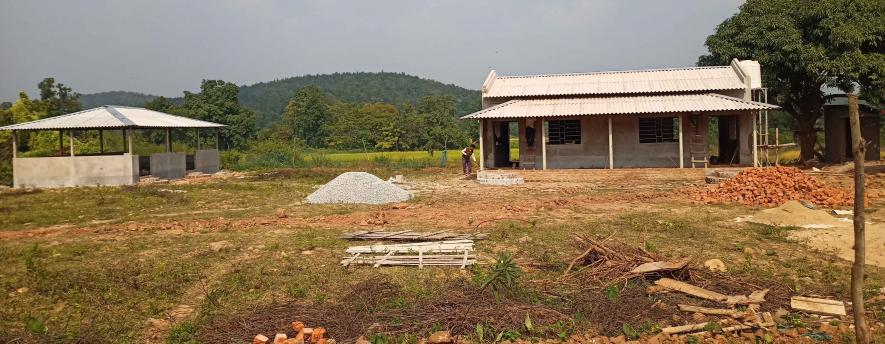
Nimai with his wife Sonamoni showing ant eggs
On the way to the Belpahari, one could see many attractive resorts running or being built, surrounded by green hills and dense verdant forests. According to locals, after the 2004 widely reported starvation incident of Amlasole, little to nothing has been done for the Sabar people. Instead, Amlasole has been developed as a tourist centre, with no participation or jobs for the indigenous primitive tribal community of Sabar people.
Right now, this remains the ground reality of Amlasole and its adjoining Sabar community areas.
There are sno Self-Help Group (SHG) in the Sabar community. The Sabar, Lodha Development Corporation is under the control of the state government, but locals say no one ever visits them
The writer covers the Jhargram region for Ganshakti newspaper in West Bengal.
Get the latest reports & analysis with people's perspective on Protests, movements & deep analytical videos, discussions of the current affairs in your Telegram app. Subscribe to NewsClick's Telegram channel & get Real-Time updates on stories, as they get published on our website.















